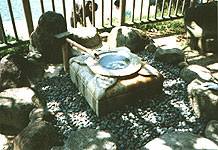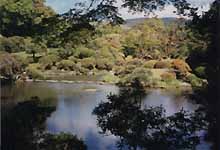5. Uki-Mi-DO
This pavillon was built in the large pond in southen part of Nara-Park.
Parhaps, it may copy a buddhist pavillon in BIWA-lake in Siga perfecture.
It hasn't any buddhist character, visiters can rest in this beutiful pavillon.
Here is very comfortable space, but too pigeons live on the roof and dirt
the pavillon. I hope the manager to eliminate the pigeons.
By the way, by the entrance road, an attaractive spot "SUI-KIN-KUTU"(the
RIGHT) is. IT is a sort of musical instrument. Pouring water on the rock
construction, one can listen beutiful natural mystic music from the underground.
Some construction was built in underground, so that water drips sound
in undergroud space like xylophone/ many puter bells. The sound is loud
than expected, so that one need not take effort to hear.
In south part of Nara-Park, Nara-city, Nara, Japan
6. Guardian beast stone sculptures in Chinese Style
There are two large stone beasts in the SOUTH GATE of Todaiji which is
famous for the biggest bronze buddha in Japan. All beginner sighseers
should pass this gate.
In 13th century, when this gate was built, Chinese sculptures made these
beasts. Many Chinese craftmen went to Japan, and worked in this temple
in the 13th century. Many scholars think sculptures of "I" family from
Nin-Po made them. "I" family became Japanese and flourished during the
13th century. Many stone reliefs are made in 13th century, in Nara. Several
may be made by "I" family, and others were probably stimulated by them.
The style is Chinese Song dynaty sculptures. Rigorous and sharp characters
impress me. The base has some figure reliefs, which especially reflect
Chinese taste.
These beasts are in the backward of the gate and fenced, moreover the
corner is dim. Although over ten thousands pass this gate by year, most
sightseers overlook them.
In Todaiji temple, Nara-city, Nara, japan.
7. 12th century style garden in Nara Outskirt.
15km east from the center of Nara-city, in the narow valley, an old temple
has this beautiful garden. This EN-JYO-JI temple was built in the 12th
century and then the garden should be built. Most architectures are re-built
in medieval period(15-17th century). A national treasure buddha statue
by the famous sculptor "UN-KEI" (13th century, KAMAKURA-period) is in
this main hall. Two small shrine in this area are the oldest shrine constructions
among such small style shrines(KASUGA-STYLE shrines).
I feel this garden should be more attractive. Comparing The DAI-JYO-IN
garden, this is small and feels a miniature, but I cannot leave this garden
for one hour. Refined scenaries and rock constructions, and a small island
compose a good taste, although topographical problem restricts this garden.
I heard that this garden was recently repaired/reconstructed, but this
scenery lead me to 12th century world.
In YAGYU, Nara. 20min by AUTOBUS( this bus usually start at NARA Station,
ONLY 4 TIMES by DAY). If you like walking, you should select your shoes
for mountain roads.
|










